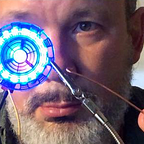“Unexpectedly Awesome…” Hardware Programming in a Freshmen-Level Business School Core Class
We want our students to get excited about coding, but too often first coding experiences involve uninspiring concepts like fibonacci sequences or find-the-prime numbers. This semester we tried something different — introducing coding through the Circuit Playground Express, a microcontroller packed with colorful LED lights, touch sensors, an accelerometer, light sensor, sound sensor, and more. Block-style MakeCode was used to introduce concepts like flow control, conditional logic, and loops, then transitioned to Python programming using CircuitPython. After a series of “flipped-class” tutorial videos and just two classroom programming sessions, students were on their own to come up with a creative “show and tell” final project.
The projects were incredibly diverse and included:
A robotic candy dispenser, a talking crystal ball, a light up dog collar, an intrusion detector, a personal training board, tech to quiet a snoring roommate, an alarm to cure cell phone addiction, a game of biz-tech jeopardy, a light saber, a talking Danny Devito, a sound board for a dog to make requests like “feed me” or “let me out”!
We also had a surprising number of musicians inspired by the produce aisle.
And of course, we did this at a Catholic University in December and we got a lot of Christmas projects: a christmas bow, python-powered ugly sweaters, high-tech antlers, achristmas story book, a buddy the elf snowglobe with soundclips, wreaths, lots of trees, and the programmable Santas got progressively larger as the week went on.
This wasn’t just fun, simple coding — students managed projects, consulted online documentation, referenced public domain tutorials and code samples, worked with different programing languages, converted files, dealt with hardware constraints, and were even able to relate this work to topics as varied as conditionals in Excel to business concepts like Standards, Network Effects, and Platform Competition. Many are now interested in channeling tech creativity into entrepreneurship, and many who hadn’t intended to code have already signed up for our zero-to-full-stack iOS app class next semester.
You’ll find video playlists for learning MakeCode and CircuitPython at on the YouTube channel at this link, and more info in these posts.
Have you found this helpful? Have additional ideas? Let me know and good luck!
Some important thank yous! Thanks to the Boston College Center for Teaching Excellence, that provided a grant so that I could buy supplies, including 100 LED light strips with alligator clips for reuse in future classes, as well as a bunch of supplies including capacitive touch paint and copper tape. And of course, HUGE to my fabulous TA team — none of whom had experience in this before our course started, and all of whom were extremely tolerant of my unreasonable deadlines, crazy ideas, early AM e-mails, and over-the-top enthusiasm. Employers, let the bidding begin for: Nicole Brito, Alex (Yu) Chang, Tiffany Daniggelis, Jenna Steichen, Sam Temple, Larissa Valdes, and Ivana Rizo Patron.
Curious about additional content? The material above is free to all and I’ll be sure to add to this over time. The award-winning text “Information Systems: A Manager’s Guide to Harnessing Technology” is updated each year, is used by over 300 programs, and is only $29.95 for an online version. “Learn to Program Using Swift for iOS Development” is a video-centric course ideal for flipped-class or online learning. Over 100 videos take students with no assumed programming experience through a “full stack” experience that ends with a “Yelp-like” restaurant review app that uses Google log-in, shared data via Google Cloud Firestore and Firebase Storage, photos, maps, and more. The entire product is just $25 online.
